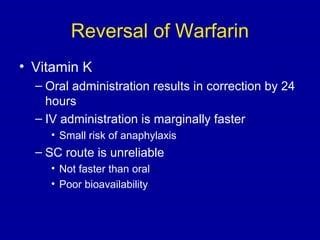Whenever a nurse is caring for clients who are receiving warfarin (Coumadin), which of the following medications should the nurse have on hand in the event of an overdose?
Protamine
Vitamin K
Atropine
Epinephrine
The Correct Answer is B
A. Protamine is used to reverse the effects of heparin, not warfarin.
B. Vitamin K is the antidote for warfarin overdose, as it promotes the synthesis of clotting factors that are inhibited by warfarin.
C. Atropine is used to treat bradycardia and other conditions, but it is not used to reverse the effects of warfarin.
D. Epinephrine is used to treat severe allergic reactions (anaphylaxis) and cardiac arrest, but it is not used to reverse the effects of warfarin.

Nursing Test Bank
Naxlex Comprehensive Predictor Exams
Related Questions
Correct Answer is B
Explanation
A. This statement is correct. HIPAA protects the privacy and security of individually identifiable health information.
B. HIPAA generally requires patient authorization for the disclosure of health information to family members.
C. Personally identifiable information includes any information that can be used to identify an individual, such as a client's name, address, or social security number.
D. HIPAA is a federal law that sets national standards for the protection of health information.
Correct Answer is C
Explanation
A. A WBC count of 5,000/mm3 is within the normal range (4,000-11,000/mm3) and is not a priority value to monitor in a client with HIV.
B. A platelet count of 150,000/mm3 is within the normal range (150,000-400,000/mm3) and is not a priority value to monitor in a client with HIV.
C. The CD4-T-cell count is a key indicator of the immune system's function in clients with HIV. A CD4-T-cell count of 180 cells/mm3 is significantly below the normal range (500-1,500 cells/mm3) and indicates a weakened immune system, which is a priority concern in clients with HIV.
D. A positive Western blot test confirms the diagnosis of HIV, but it does not provide information about the severity of the client's condition or their immune system function.
Whether you are a student looking to ace your exams or a practicing nurse seeking to enhance your expertise , our nursing education contents will empower you with the confidence and competence to make a difference in the lives of patients and become a respected leader in the healthcare field.
Visit Naxlex, invest in your future and unlock endless possibilities with our unparalleled nursing education contents today
Report Wrong Answer on the Current Question
Do you disagree with the answer? If yes, what is your expected answer? Explain.
Kindly be descriptive with the issue you are facing.
